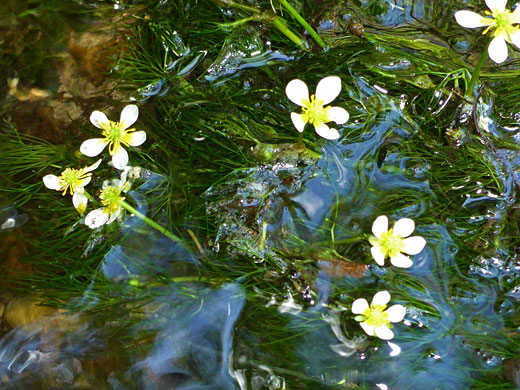Ranunculus Aquatilis, White Water Buttercup
Plants > Wildflowers > Ranunculaceae > Ranunculus Aquatilis
Common names:
White water buttercup, common water-crowfoot
Family:
Scientific name:
Ranunculus aquatilis
Synonym:
Ranunculus longirostris
Main flower color:
Range:
All the western states
Height:
A few inches - stems are aquatic or creeping, up to 30 inches long
Habitat:
Streams, lakes, ponds, marshes, from sea level to 10,000 feet
Leaves:
Divided into fine, thread-like segments, sometimes also with broader, kidney-shaped leaves divided into three lobes
Season:
April to September
Ranunculus aquatilis is an easy species to identify on account of its finely divided, thread-like leaves, the white petals, and the habitat, of still or flowing water. Stems are hairless, and either submerged in water, or prostrate, on muddy banks beside rivers and ponds. For plants in water the leaves may be floating or submerged. Plants may have leaves that are all dissected into thread-like segments (var diffusus, generally found in flowing water), or may additionally have broader, flat leaves, partly divided into three coarsely-toothed lobes (var aquatilis, more likely in still water, or aquatic margins).
The flowers, which are produced at the leaf nodes and are attached by long pedicels that rise an inch or so above the water, have five white petals, yellow towards the base. The five sepals, about half as long as the petals, are somewhat cupped, and spreading to reflexed. Sepals wither early during the flowering stage.
The flowers, which are produced at the leaf nodes and are attached by long pedicels that rise an inch or so above the water, have five white petals, yellow towards the base. The five sepals, about half as long as the petals, are somewhat cupped, and spreading to reflexed. Sepals wither early during the flowering stage.
All Contents © Copyright The American Southwest | Comments and Questions | Contribute | Site Map


